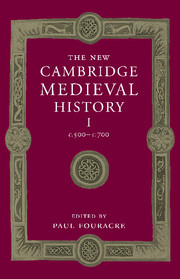Book contents
- Frontmatter
- Introduction: the history of Europe 500–700
- 1 The later Roman Empire
- 2 The Barbarian invasions
- 3 The sources and their interpretation
- PART I THE SIXTH CENTURY
- PART II THE SEVENTH CENTURY
- 11 The Byzantine empire in the seventh century
- 12 Muhammad and the rise of Islam
- 13 The Catholic Visigothic kingdom
- 14 Francia in the seventh century
- 15 Religion and society in Ireland
- 16 Christianity amongst the Britons, Dalriadan Irish and Picts
- 17 England in the seventh century
- 18 Scandinavia
- 19 The Slavs
- PART III THEMES AND PROBLEMS
- List of Primary sources
- Bibliography of secondary works arranged by chapter
- Index
- Frontispiece"
- Plate section"
- Map 3 Gaul/Francia in the sixth and seventh centuries"
- References
12 - Muhammad and the rise of Islam
from PART II - THE SEVENTH CENTURY
Published online by Cambridge University Press: 28 March 2008
- Frontmatter
- Introduction: the history of Europe 500–700
- 1 The later Roman Empire
- 2 The Barbarian invasions
- 3 The sources and their interpretation
- PART I THE SIXTH CENTURY
- PART II THE SEVENTH CENTURY
- 11 The Byzantine empire in the seventh century
- 12 Muhammad and the rise of Islam
- 13 The Catholic Visigothic kingdom
- 14 Francia in the seventh century
- 15 Religion and society in Ireland
- 16 Christianity amongst the Britons, Dalriadan Irish and Picts
- 17 England in the seventh century
- 18 Scandinavia
- 19 The Slavs
- PART III THEMES AND PROBLEMS
- List of Primary sources
- Bibliography of secondary works arranged by chapter
- Index
- Frontispiece"
- Plate section"
- Map 3 Gaul/Francia in the sixth and seventh centuries"
- References
Summary
pre-islamic arabia
Traditionally, scholars have drawn a firm distinction between south Arabia (especially the south-western corner which corresponds to modern Yemen) and the rest of the peninsula. Although, as we shall see later, it is unhelpful to draw too crude a division between south and north, the dichotomy is essentially dictated by geography: most of Arabia in late antique times consisted predominantly of vast areas of desert, fringed with oases, whilst the southern part of the peninsula, the ‘Arabia Felix’ of the ancients, was blessed with abundant and regular rainfall and could support a highly developed agriculture, underpinned by extensive and elaborate irrigation systems.
South Arabia was thickly populated, its inhabitants were largely sedentarised and agriculturalist from around the eighth century bc and its towns had provided a milieu conducive to the development of political institutions and material culture. A few kingdoms or city-states, such as Ma’n, Saba’, Qataban and Hadramawt, stand out from the blurred outlines of south Arabian history, based as it is on oral tradition. Such states could enjoy brief periods of independent power or could become united for a while, as was the case with the kingdom of Himyar around the beginning of the fourth century ad.
Keywords
Information
- Type
- Chapter
- Information
- The New Cambridge Medieval History , pp. 317 - 345Publisher: Cambridge University PressPrint publication year: 2005
